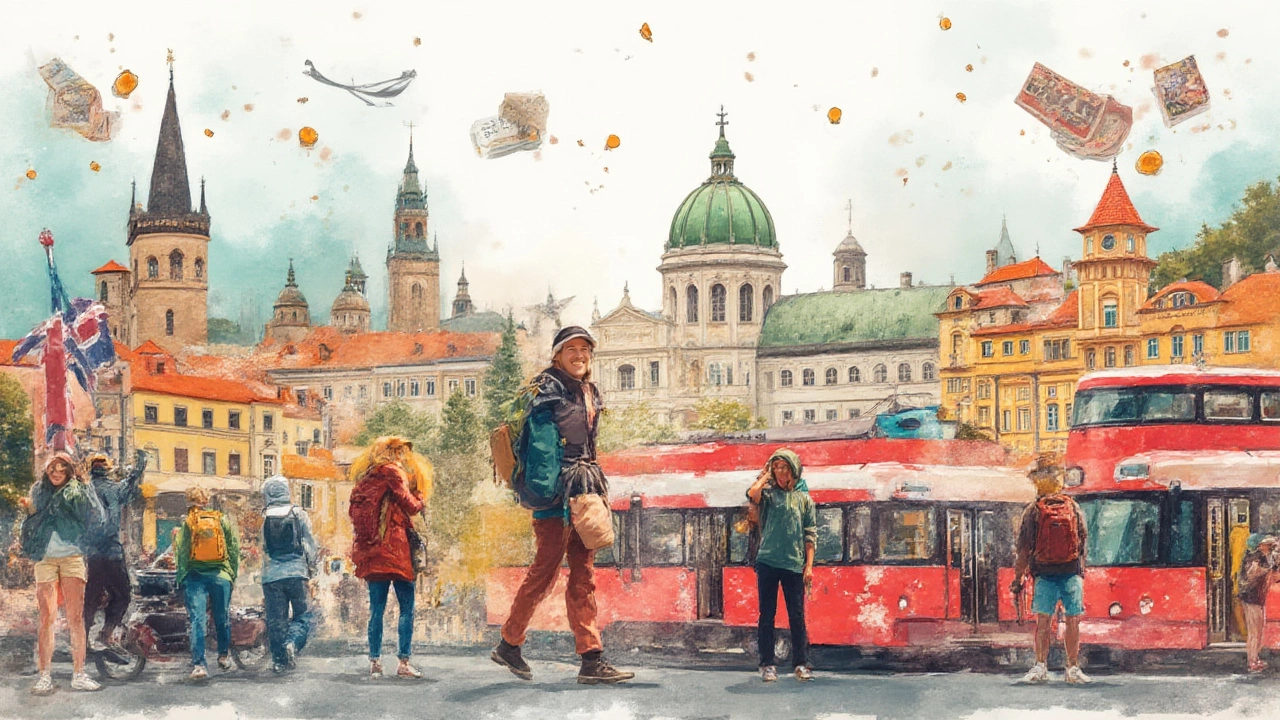Why does every coffee shop in Toronto sound like a United Nations summit these days? It’s the rise of the city break. People crave short, sharp bursts of adventure—maybe just enough to break up the slog of work or school—and they want it cheap. But let’s face it: not every city is created equal when it comes to stretching a dollar, euro, or zloty. So, what *is* the cheapest city break, anyway? If you’ve ever found yourself stuck in a doom scroll of travel deals late at night, holding your breath every time flight prices auto-refresh, you’re in exactly the right place. Whether you dream of medieval squares, café breakfasts that cost less than a Starbucks latte, or hopping between galleries and gardens without triggering an overdraft warning, the answers are here. Smart travelers know you don’t need to fork out a fortune for memories that last.
Understanding the Real Cost of a City Break
First things first: what actually makes a city break cheap? It’s not just airfare. To get a solid answer, you’ve got to think way beyond the lowest flight you spot on Google. The real calculation includes places to stay, food and drink, local transport, must-see sights, and a bit for those sneaky extras—like museum tickets or the odd selfie stick you regret buying. A city might have bargain flights from major hubs, yet punish your wallet the moment you land (looking at you, Zurich). So, when seeking the cheapest city break, thinking about the ‘total cost of experience’ is crucial.
Budget-travel watchdogs and journals regularly tally up basket-of-goods comparisons for European cities—price of a cappuccino, metro ticket, entry to a main gallery, and an overnight stay in a well-rated hostel or budget hotel. Warsaw, Krakow, Budapest, and Prague pop up so often you’d think they’re hosting a sale year-round. Here’s why these cities hit the sweet spot: they’ve got rich sights, reliable public transport, hostels and guesthouses offering beds for less than the cost of two movie tickets back home, and a foodie scene where a hearty lunch rarely overtakes €7. Not convinced? Let’s go deeper, and look at concrete numbers.
| City | 3* Hotel (per night) | Coffee | Meal | Public Transit (1 day) | Museum Entry |
|---|---|---|---|---|---|
| Krakow | €45 | €2 | €7 | €3 | €5 |
| Budapest | €50 | €1.80 | €8 | €3.50 | €6 |
| Riga | €40 | €2 | €7 | €3 | €6 |
| Prague | €60 | €2.50 | €10 | €3 | €7 |
Numbers tell a story: A three-night stay in Krakow including central accommodation, meals, and a couple of must-sees will probably run you less than a single night in Paris during high season. Warsaw is catching up too, with new hostels popping up near the Old Town and local food markets that make you wonder if someone forgot a zero on the price tag. If you’re coming from Canada, budget airlines like Ryanair or Wizz Air make these cities accessible from most major European hubs—often for the price of Friday night takeout.
But let’s not assume cheap has to mean boring. The reason these cities score so high isn’t just the price. They serve up medieval castles, jaw-dropping squares, and wild nightlife. Fancy a day where you wander cobblestone lanes, pop into a café for a decadent slice of cake, hit a music bar at night, and still come home with change from a €20 bill? Eastern Europe is your playground.
There are city-specific quirks too. Budapest’s ruin bars, built in the shells of old apartments decorated with thrift-store finds, make for a madly Instagrammable night out—without costing more than a local bus ticket. Krakow’s milk bars (bar mleczny) are government-subsidized canteens from a different era, still serving up pierogies and soup so cheap your inner grandma will weep with joy. If you’re a culture hound, most museums in Riga offer free admission on certain days, and several art galleries in Prague won’t charge a single crown.
Accommodation makes a huge difference. In most of these Eastern gems, you’ll find private rooms in family-run guesthouses for the cost of a bed in a grimy hostel elsewhere. For solo travelers, hostels double as instant social hubs, offering free walking tours or pub crawls—making it easier to see the city and meet people (without paying for a guide).
Travel tip: Always check local tourist cards (like Budapest Card), which can cover transport and provide hefty discounts at attractions. Often, these pay for themselves within a day, so don’t ignore the little leaflet at the airport counter. And if you’re flying, book early or be flexible with your days—midweek flights are nearly always cheaper.
Maybe the best part? Even when you splurge, life is still cheap here. A river cruise on the Danube in Budapest, or a day trip to the Wieliczka Salt Mines near Krakow, costs less than a couple of cocktails in Paris’ Marais district. All this without losing the buzz that makes a city break extra special—after all, who wants to come home and eat buttered noodles for a month because they overspent on souvenirs or one too many Aperol spritzes?

European City Breaks: The Best Bang for Your Buck
If you want maximum adventure for your budget, here’s where to look. Eastern and Central Europe have quietly become the deal-hunter’s dream in the last decade. Cities like Sofia (Bulgaria), Vilnius (Lithuania), and Belgrade (Serbia) have shot onto the radar, thanks to social media and budget airline routes expanding out of London, Frankfurt, and even Toronto’s Pearson during promo seasons.
Krakow isn’t just Poland’s postcard—the whole place is practically a living museum, wrapped around the gigantic Main Market Square. Where else can you tour a 13th-century underground salt mine, tick off a UNESCO castle, and stumble into jazz basements packed until dawn—all in one weekend, and typically on the change in your pocket? Krakow’s food markets, like Stary Kleparz, are bursting with fresh dumplings, local cheese, and plump forest berries, while tiny bars in Kazimierz (the old Jewish quarter) serve vodka shots for pocket change. Tip: Look out for zapiekanki, Poland’s take on an open-faced baguette pizza—filling, delicious, and almost comically cheap.
Budapest meanwhile is split by the Danube, giving you two cities for the price of one—Buda’s castle district and the busy, lively Pest. The baths are unmissable. Imagine floating in century-old pools under open roofs, the water warm even in a March snowfall—and the entry price nowhere near what you’d pay for a spa day in Western Europe. Food? Hungarian stews, chimney cake, and cheap, fruity wine. Budapest is also a hub for cheap day trips: hop a train to Eger for less than a large coffee back home and find yourself tasting wine in medieval cellars.
Riga deserves a special nod too. Latvia’s capital is packed with art nouveau buildings, forested parks, and a surprising foodie scene. Summer nights feel endless, so bring extra memory cards—this place glows at golden hour. Budget travelers can feast on smoked fish and rye at the Central Market (a UNESCO site itself), while sneaking into quirky museums (the Latvian War Museum is free). Even the best clubs in Riga rarely charge more than a €5 cover.
Don’t write off Sofia if you’re craving a different flavor. Bulgaria’s capital is a jolt of ancient Roman ruins, Ottoman baths, and Orthodox domes, all at prices that’ll spoil you for any Western European city. Sofia’s mountain hikes are just a tram ride away, and cozy cafes do breakfast for the price of a bus ticket in Toronto. For something truly offbeat, Zagreb in Croatia has been gaining love for its quirky Museum of Broken Relationships and easy bus links to Plitvice Lakes—again, all on a solid shoestring.
Avoiding the biggest tourist honey-pots—Paris, London, Rome—saves a small fortune. Average cost of a pint in Prague? €2. London? €7, if you’re lucky. Prague mixes fairy-tale Old Town with huge beer halls and bakeries. It’s true, prices have climbed slightly since joining the EU, but compared to Western capitals, it’s still a steal.
So, how to actually bag a cheap city break? Browse fares with flexible dates first. Tuesday departures almost always undercut Friday or Saturday. Focus on cities with super-competitive hotel and hostel scenes—you want places where supply regularly outstrips demand. If free attractions are your thing, look up walking tours (most operate on tips), free museum days, and city cards that bundle sights and transport. Don’t forget those random last-minute deals, too: the best ones often pop up outside the ‘biggest’ seasons—think late spring or early autumn.
For Canadians, avoiding summer and school breaks means you’ll actually *enjoy* the city, not just herd through selfie-stick crowds. If flying from Toronto or Montreal, compare Ryanair, EasyJet, or Wizz Air via cities like Dublin, London, or Frankfurt—connections often work out cheaper than direct flights. Don’t be afraid to get creative about routes and stop-overs. Sometimes the journey’s part of the fun (and the savings).
| City | Flight from London (off-peak) | Pint of Beer | Hostel (per night) | Main Attraction Ticket |
|---|---|---|---|---|
| Budapest | £34 | £1.80 | £10 | £8 |
| Sofia | £26 | £1.50 | £8 | £5 |
| Riga | £38 | £2 | £12 | £6 |
| Belgrade | £45 | £1.20 | £10 | £4 |
The beauty of all these cities is flexibility. Want nightlife, ancient walls, or cheap eats? Pick your favorite, and just go. Don’t let fancy Instagram posts convince you you need all the bells and whistles of Paris to have a magical weekend. Sometimes the best finds are in tiny cobbled alleys—where nobody’s jacking up prices for the tourist bus that just left.
Quick rundown for cheap city break essentials:
- Book flights *early*—six weeks out for best deals
- Compare accommodation types—private hostel rooms, Airbnbs, guesthouses
- Hunt out city cards for free transport/museums
- Eats: Try local food markets and snack bars
- Avoid big tourist events and local holidays (prices spike!)
Stick to these, and your next cheap city break will be a memory—not a credit card regret story.

Travel Hacks for Squeezing Every Last Cent
Once you’ve zeroed in on your city, there’s still room for ninja-level savings. It’s not just about where you go, but how you move, book, and live while you’re there. Here’s where seasoned travelers (and, okay, the eternally broke students among us) really shine. Let’s demystify the art of squeezing every last cent from your getaway.
First, always cross-check fare trackers (like Skyscanner) using ‘whole month’ views. A difference of three days can slice a flight bill in half, especially to lesser-known destinations. Booking distant airport arrivals? Weigh up transit times and ticket costs—sometimes the “cheapest” flight lands at an airport 50km away, where shuttles cost more than the airfare. If a city’s got a good rail connection, you’re golden; if not, rethink your plan.
Accommodation can make or break your trip’s budget. Aim for local guesthouses or apartments instead of chain hotels—bonus if the place has a kitchen (even hostels usually do). Just cooking a couple of breakfasts or one basic dinner can slash daily spending. Pick places near main sights or handy transit lines. If you’re flying in for just two or three nights, time is the greatest expense; don’t waste it schlep running across town after a cheap room. When in doubt, check backpacker forums or review sites—not just for bargains, but for up-to-date tips about local scams or price spikes.
Eating out? Daytime is your friend. Many cities offer set ‘menu’ lunches (like Poland’s ‘zestaw dnia’ or Hungary’s ‘menü’)—three small plates for less than what a single course would cost at dinner. Bakeries and market kiosks are lifesavers for cheap, filling snacks. That street vendor with a queue of locals is usually both delicious and wallet-friendly. If you want a treat, go to the places just off main tourist drags—often half the price for the same dish. And water: always check if tap water’s safe to drink (it is, in most European cities), so skip bottled and refill as you go.
Transport tips can make travel fun again. In cities with compact old towns, you’ll save most by walking. For longer hops, buy a daily transit pass; a couple of metro rides quickly repays it. In Budapest, Prague, and Warsaw, trams are a treat in themselves, rattling through neighborhoods you’d never tour by car. If you plan day-trips, compare bus with rail—buses are often cheaper, less glamorous, but get you into small towns fast.
Seeing the sights doesn’t mean emptying your wallet. Free walking tours are everywhere now, and they’re not just for students: guides know the history, hidden food stalls, and shortcuts that’d take you hours to find on your own. Free museum days or discounted evenings happen even in Prague and Budapest—check city tourism websites or hostel bulletin boards. If street art and quirky neighborhoods are your thing, you can map whole afternoons without spending anything. Want to socialize? Many hostels and guesthouses organize pub crawls, board game nights, or potluck dinners for next to nothing.
If you’re after souvenirs, dodge the airport shops entirely. Head for markets, independent bookshops, or flea fairs. Local snacks, small textiles, or unique crafts are easy to pack and much more meaningful than anything stamped ‘I <3 (city name)’. Set a strict limit—souvenir buying can creep up fast, but the thrill is in hunting down something authentic for a fraction of the price.
An underrated hack for budget city breaks: travel light. Many low-cost airlines charge more for checked bags than for tickets. A carry-on and wearable outfits double your savings. Bonus: You breeze through airports and never worry about losing your bag en route.
Data and navigation? Free city Wi-Fi is standard in most European hubs, but a cheap prepaid SIM is worth it in the longer run, especially for maps, ride-hail apps, and surprise schedule changes. Check where your phone’s supported (luckily, EU roaming is standardized, so a SIM from Poland works in Prague and Budapest, too).
For final inspiration, here’s a show-stopping truth: The magic of city breaks isn’t in ticking off the ‘famous’ sights, but in the small, serendipitous moments—concert in a cellar, chat with a market vendor, lingering in a sunlit square. None of these cost a fortune, and they’re far more memorable than a big-ticket bus tour. When you plan smart, spend mindfully, and travel with a bit of boldness, even the cheapest city break turns into a story you tell for years. Finding the spot that fires up your imagination *and* protects your bank balance? That’s the real jackpot. So—ready to pack?
